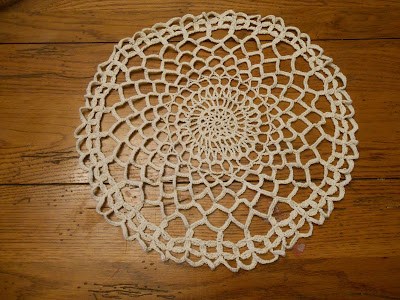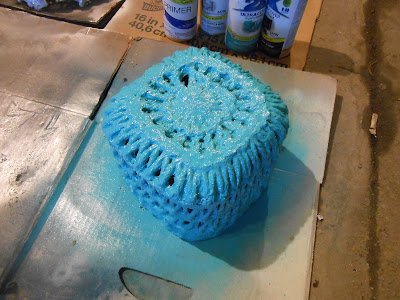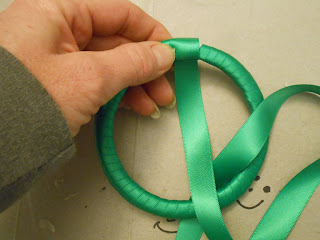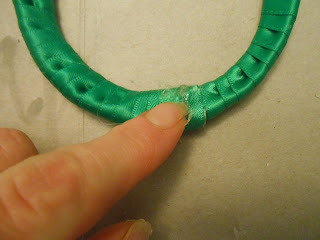Skip the starch the next time you want to make something with doilies or any of those crocheted items you have laying around. Instead, how about using a cement slurry to stiffen them up permanently? You can create beautiful items for your home re-purposing doilies or other crocheted items (even knit hats!) into bowls, planters, Christmas ornaments, candle holder, wall hangings or anything else your heart desires. I have to buy my doilies at estate sales, thrift stores and sometimes yard sales but if you are lucky to know how to crochet or know someone who does the possibilities are nearly endless for design ideas!
 |
| Cement lace bowl |
 |
| Cement lace bowl |
 |
| Planter made with cement slurry and a crochet hat |
If you are ready then let's get to work making some cement lace:-)) The ingredients for your cement lace:
1. Doilies made from cotton or other absorbent material. Items made from yarn, such as granny squares also work well. Another tip is to use doilies made with thicker "string" or thread for a firmer and stronger result. Note: doilies made from plastic, paper or other non-absorbent material will not work for this.
Make sure your doilies are clean and free from starch or other stiffeners. Wash and allow to dry completely before you start this project. You want the doilies to absorb as much of the cement as possible. Here are just a few of the doilies I have used:
 |
| Crochet doily |
 |
| Crochet doily |
 |
| Crochet doily |
 |
| Crochet doilies |
2. Concrete bonding additive-this is sold by most of your home improvement and hardware stores usually by the concrete and cement products. This is an important ingredient.
 |
| Concrete bonding additive |
 |
| Portland cement |
Other items you will need:
1. Dust mask (Always wear your dust mask when using cement products!)
2. Fine sieve
3. Measuring tool-I used a small plastic container
4. Long gloves (This mixture is strong and will burn your arms if splashed on them-trust me!)
5. Cooking spray or some other mold release
6. Safety glasses (Always wear your safety glasses!)
7. A sheet of plastic
8. A paint brush
9. Molds-plastic is my mold of choice since it is the easiest to work with. Wood works well. Glass and metal are just too difficult (sometimes impossible) to remove your cement piece from.
 |
| Supplies needed for making cement lace |
5 parts sifted portland cement.
1 part concrete bonding additive.
enough water to make a pudding consistency.
Make sure that the area where you are working in is above 50 degrees but below 90 for both mixing and curing times.
The first step for creating your cement lace is to pick and prepare your containers (I prefer plastic and wood) Note: if you are concerned about the cement releasing then cover your molds with some type of plastic like shopping bags or saran wrap.
You can make any shape you want like bowls, or you can lay them flat to make ornaments or you can make planter shapes. It is all up to you:-)) Lay them out on a sheet of plastic like this (it can get messy):
 |
| Crochet doilies |
 |
| Crochet hat |
When you have the shapes you want then spray your containers with mold release then wipe off the excess. I like to use cooking spray:
 |
| Mold release for cement projects |
 |
| Sift portland cement |
Throw away any hard lumps in to the garbage:
You want a fine powder with no lumps:
Third, add your 1 part (1 measuring container) concrete bonding additive. You are creating a cement slurry:
 |
| Add concrete additive to sifted portland |
Add some water-not very much-about a half a part to begin with and mix. If it is still dry add a little water at a time until you have the consistency of pudding.
 |
| Mix cement slurry |
 |
| Place crochet doily in cement slurry |
 |
| Crochet doily covered in cement slurry |
Lay it on the "mold". Adjust the doily until you have it in the position you want. Try to center it as much as possible then take an old paint brush and wipe off the excess cement if there is any:
 |
| Smooth out cement coated crochet doily |
When you are done with all of your doilies they are now ready to cure:
 |
| Cement soaked crochet doilies |
 |
| Hard to the touch |
 |
| Hard to the touch |
Make sure they stay damp under the plastic-mist daily if necessary to keep them damp.
After at least a week you can uncover them and unmold them. If you use plastic they should release fairly easily. Do not force it from the mold-just work it off gently or tap it gently. The more flexible the plastic the easier it is to release.
When they are unmolded allow the cement lace to "dry" for a couple more weeks. This will allow the moisture to evaporate so that the sealant or paint that is applied bonds to the cement. If the cement is not allowed to dry thoroughly the sealant and/or paint will not adhere and will peel off prematurely.
If you have a few rough spots on your cement lace gently sand with a sanding block-do not sand too much or you will remove the cement.
After a few weeks you can now paint your cement lace. A quality spray paint such as Rustoleum Universal or Rustoleum 2 in 1 with primer work great and they are what I use but there are concrete paints out there that will work. Quality craft paints will also work. Just remember to seal your cement lace after painting or if you wish to use your cement lace for food purposes make sure to seal with a food safe sealer.

Here they are put to use:


I hope my post has inspired you to re-purpose those doilies into an original and beautiful piece of home decor that will last. Just remember that there are so many possibilities to what you can make using this idea so get out there and create something for yourself (or someone else)! I would love to see your work so feel free to post pics in the comment section or you can post them on my Facebook page at this link: https://www.facebook.com/sproutsandstuff/ .
If you have any questions or comments please leave them below. I would love to hear from you!
Happy Gardening! Rhonda










































